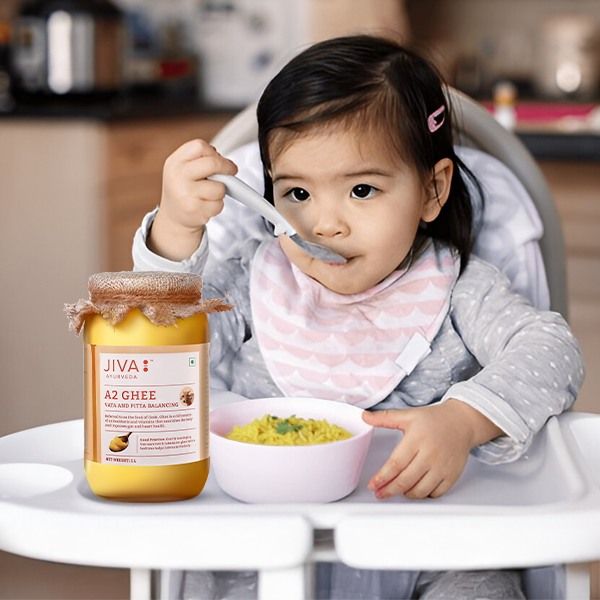
Is your baby getting all the nutrition they need after weaning them onto solids?
JIVA A2 Ghee is the ultimate superfood you need to have in your baby’s diet when it’s time to introduce solid foods!
Since the arrival of your bundle of joy, everything they need will be as it should be—top priority!
Every milestone they meet is a reason to celebrate, be it their laughter, cooing, their first words, or their first steps.
And while you wait patiently for the next milestone, be sure you only choose the best foods for your baby, for that will provide them with the energy they need to grow.
So, when you check fresh fruits, veggies, cereal, etc., off your list, be sure to add the golden elixir—our very own JIVA A2 ghee to it.
Why? Because JIVA A2 ghee has the healthy fats that your little one needs to nourish their body and keep them physically and mentally active.
The benefits don’t stop here. Read on to learn more!
Why Should You Introduce A2 Ghee to Your Baby?
Ghee, in general, is a high-calorie, nutrient-rich food, but A2 ghee has more to offer compared to regular ghee.
Here, you’ll learn the primary advantages of A2 ghee for babies, but before we proceed, you must note that this ghee only offers preventive health benefits for the ailments we have addressed below.
1. Healthy and Safe Ghee
Safety and health are non-negotiable for your little one. Choose foods that are free from chemicals and synthetic fertilizers, such as JIVA A2 Ghee. Also called A2 Gir Cow Ghee, It is organic, safe, and of course healthy, as it is made from A2 cow milk, which comes from desi or purebred cows, such as Gir and Sahiwal.
The best thing about purebred cows is that they are raised on fields grown with no pesticides, and they undergo zero hormonal treatments. Moreover, A2 ghee is made using the traditional bilona method, which ensures it remains nutrient-dense than the ghee derived from hybrid cow milk. It is therefore also called bilona cow ghee, a safer and healthier alternative to A1 or regular ghee.
2. Nutritional Powerhouse
Your baby needs foods that support their growth and development. A2 ghee is a nutritional powerhouse. It consists of monounsaturated and polyunsaturated fatty acids (omega-3, omega-6, and omega-9 fatty acids), fat-soluble vitamins (vitamins A, D, E, and K), and minerals, such as calcium, phosphorous, zinc, and magnesium. It, therefore, has anti-microbial, antioxidant, and anti-inflammatory properties, which help boost your child’s immunity and maintain overall well-being.
3. Gentle on Their Tummy
You know how delicate your little one’s digestive system is, especially when you’re transitioning their diet to solid foods. Therefore, you need foods that are gentle on their stomach and act as digestive aid.
A2 ghee contains A2 protein and butyric acid that makes it easier to digest, unlike regular or A1 ghee, which can cause gas, discomfort, and liquid or frothy stools. A2 ghee also helps repair and enhance the barrier function of the intestine and maintain a healthy gut flora. This promotes better absorption of nutrients and make A2 ghee an immune booster.
4. Fuels Their Brain
Your baby’s brain will undergo immense transformation in a very short time. Foods that support brain development and cognitive function are crucial for them. Ghee supports neurological development in babies and long-term potentiation (LTP) of the brain. What is LTP? It is a type of plasticity that occurs in the brain and is activity-dependent and important for building your baby’s learning abilities and memory.
5. Strengthens Their Bones
Tiny bones today will gain superhero strength tomorrow with JIVA A2 Ghee! It will support a whole lot of running around your child will be indulging in in the later stages of their life. The ghee contains vitamin D, and as stated above, it supports digestive and intestinal health, and together, they help in the absorption of calcium, which are essential to strengthen your baby’s bones and give them the much-needed energy boost to remain active.
6. Supports Their Eyesight, Lungs, and Heart Health
You must feed your little one JIVA A2 Ghee for the endless giggles that their healthy lungs will ensure, for a sharp eyesight that they need to absorb the wonders of the world, wide-eyed, and for a healthy heart that will have immense love to give to the world!
A2 ghee is a good source of Vitamin A, which when consumed, can benefit your baby’s eyesight, heart and respiratory health. Traditionally, ghee is also used as topical treatment. Ghee massage for babies is quite beneficial in itself; however, refrain from using it as eye drops, especially without the guidance of an expert. Your baby’s eyes are extremely delicate at this stage.
7. Shields Their Health
Protect your baby’s cells from oxidative damage with JIVA A2 ghee. It has antioxidant properties, which may help reduce the effects of free radicals and give your baby the healthy start they deserve.
8. Helps Gain Weight
A healthy weight defines a happy baby. Your baby’s weight is an important factor when it comes to their well-being. Ghee, A2 in particular, is a high-calorie food that can help you ensure that your baby gets their dose of healthy fats to keep their weight in check.
You must, however, remember that excess of anything, no matter how healthy it is, is not beneficial for your child. As is the case with most foods, ghee must also be consumed in moderation. Excessive consumption can lead to obesity and consequent health issues.
Now that you know the A2 ghee benefits for babies, we’re sure that you’re curious about how and when you should introduce ghee into your little one. Stay with us and you’ll know!
How to Introduce Ghee to Your Baby?
Weaning babies onto solids will need you to be immensely patient. Here’s a guide you can follow when introducing ghee for newborns.
1. Choose Authentic A2 Ghee
Always choose authentic, high-quality A2 ghee, like JIVA A2 Ghee, that is made using the traditional bilona method. This technique of making A2 ghee ensures the ghee remains nutrient-dense yet easy to digest.
2. Integrate Foods
Your baby has their preferences, too. They will enjoy some foods and dislike some because of the taste or the texture. Thus, when you start adding ghee to their diet, add a small quantity to the foods that you’ve already been feeding them for a while. This will help mask the new taste, aroma, and texture of ghee till they get used to it.
3. Warm the Ghee
Warming the ghee melts the texture, allowing your little one to swallow the ghee effortlessly. Ghee at room temperature has solidified bits which could be challenging for the baby to consume. Just be careful, though, to not feed them hot ghee as that could burn their mouth. Always blow air and touch to check its temperature before feeding A2 ghee to your baby.
4. Take Baby Steps
Yes, you must also take baby steps. As in, start small when you introduce new foods to your baby. That way, you can feed freshly cooked servings in tolerable amounts to allow your baby’s body to assimilate or develop a taste for them. You must do the same with A2 ghee as well. Start with ½ teaspoon and continue with this quantity for a month at least if your baby doesn’t develop allergic reactions, which co-incidentally is also the next advice for you.
5. Check for Allergies and Unusual Developmental Changes
A little check goes a long way in keeping your baby healthy. Even though A2 ghee is easy to digest, your infant’s body might respond differently than expected. Thus, keep an eye out for allergic reactions.
Here’s a tip for new parents—when you introduce new foods, always leave a gap of 2-3 days between the servings to observe your baby for any reactions. At times, babies might show sudden or unusual developmental changes. It’s best to consult your paediatrician immediately if you observe such signs.
6. Increase Bite By Bite
Ease your baby into the new diet. Start slow and gradually build onto it. Once you’re sure that your baby is not allergic to A2 ghee, increase the quantity to maintain a perfect balance that benefits their health. We recommend you follow the serving sizes we’ve shared below to practice moderation.
7. Know When to Steer Clear
Spot the red flags and avoid ghee completely when you see signs of intolerance and symptoms of cold, jaundice, hepatitis, or any other liver disorder. You must consult your paediatrician promptly if need be.
When is Your Baby Ready for A2 Ghee?
Understanding the golden moment to add A2 ghee to your little one’s diet is crucial. Ideally, babies are weaned onto solids when they turn 6 months old. For a healthy start, you can introduce A2 ghee anytime between 6-8 months—once they can comfortably digest a few solids. Having said that, if you’re not sure when to begin, consult your paediatrician and follow the diet they recommend for your baby.
How Much A2 Ghee is Right for Your Baby?
Even though just a spoonful of JIVA A2 Ghee is all you need to nourish your baby’s body, start with a serving that’s safe and healthy for them.
As advised above, once you introduce A2 ghee to your baby, keep a gap of 2-3 days between servings.
In other words, feed your baby about ½ teaspoon of ghee once every 2-3 days.
Observe the baby for reactions or allergies. Once they can digest ghee and suffer no reactions, gradually increase the frequency till your child can tolerate and digest it after being fed 2-3 times a day.
Post this, you can increase the serving size as per the guidelines given below, and follow them 2-3 times a day:
• Ghee for 6 month baby – ½ teaspoon
• Ghee for 8 month baby – ¾ teaspoon
• Ghee for 10 month baby - 1 teaspoon
• Ghee for 1 year baby – 1 to 1 ½ teaspoon
• Ghee for 2 year baby – 1 ½ to 2 teaspoons
Now you know that 6 months is a sweet spot for you to introduce JIVA A2 ghee to your baby. With JIVA, you will be adding the purest, most nourishing ghee to your little one’s meals and enhancing their health and well-being. So, why wait? Buy A2 ghee for babies now! It’s the superfood your baby needs to begin their journey to health.







